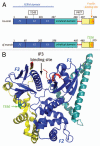Emerging role for ERM proteins in cell adhesion and migration
- PMID: 21343695
- PMCID: PMC3084986
- DOI: 10.4161/cam.5.2.15081
Emerging role for ERM proteins in cell adhesion and migration
Abstract
The highly related ERM (Ezrin, Radixin, Moesin) proteins provide a regulated linkage between the membrane and the underlying actin cytoskeleton. They also provide a platform for the transmission of signals in responses to extracellular cues. Studies in different model organisms and in cultured cells have highlighted the importance of ERM proteins in the generation and maintenance of specific domains of the plasma membrane. A central question is how do ERM proteins coordinate actin filament organization and membrane protein transport/stability with signal transduction pathways to build up complex structures? Through their interaction with numerous partners including membrane proteins, actin cytoskeleton and signaling molecules, ERM proteins have the ability to organize multiprotein complexes in specific cellular compartments. Likewise, ERM proteins participate in diverse functions including cell morphogenesis, endocytosis/exocytosis, adhesion and migration. This review focuses on aspects still poorly understood related to the function of ERM proteins in epithelial cell adhesion and migration.
Figures


Similar articles
-
ERM proteins in epithelial cell organization and functions.Biochim Biophys Acta. 2007 May;1773(5):653-60. doi: 10.1016/j.bbamcr.2006.06.013. Epub 2006 Jul 10. Biochim Biophys Acta. 2007. PMID: 16904765 Review.
-
ERM proteins: from cellular architecture to cell signaling.Biol Cell. 2000 Aug;92(5):305-16. doi: 10.1016/s0248-4900(00)01078-9. Biol Cell. 2000. PMID: 11071040 Review.
-
The C. elegans ezrin-radixin-moesin protein ERM-1 is necessary for apical junction remodelling and tubulogenesis in the intestine.Dev Biol. 2004 Aug 1;272(1):262-76. doi: 10.1016/j.ydbio.2004.05.012. Dev Biol. 2004. PMID: 15242805
-
Ezrin-radixin-moesin (ERM)-binding phosphoprotein 50 organizes ERM proteins at the apical membrane of polarized epithelia.Proc Natl Acad Sci U S A. 2004 Dec 21;101(51):17705-10. doi: 10.1073/pnas.0407974101. Epub 2004 Dec 10. Proc Natl Acad Sci U S A. 2004. PMID: 15591354 Free PMC article.
-
Inhibition of cell adhesion by phosphorylated Ezrin/Radixin/Moesin.Cell Adh Migr. 2015;9(6):502-12. doi: 10.1080/19336918.2015.1113366. Cell Adh Migr. 2015. PMID: 26555866 Free PMC article.
Cited by
-
Long Noncoding RNA EZR-AS1 Regulates the Proliferation, Migration, and Apoptosis of Human Venous Endothelial Cells via SMYD3.Biomed Res Int. 2020 May 22;2020:6840234. doi: 10.1155/2020/6840234. eCollection 2020. Biomed Res Int. 2020. PMID: 32596350 Free PMC article.
-
Myosins as fundamental components during tumorigenesis: diverse and indispensable.Oncotarget. 2016 Jul 19;7(29):46785-46812. doi: 10.18632/oncotarget.8800. Oncotarget. 2016. PMID: 27121062 Free PMC article. Review.
-
Ezrin and E-cadherin expression profile in cervical cytology: a prognostic marker for tumor progression in cervical cancer.BMC Cancer. 2018 Mar 27;18(1):349. doi: 10.1186/s12885-018-4243-7. BMC Cancer. 2018. PMID: 29587669 Free PMC article.
-
Radixin enhances colon cancer cell invasion by increasing MMP-7 production via Rac1-ERK pathway.ScientificWorldJournal. 2014;2014:340271. doi: 10.1155/2014/340271. Epub 2014 Jul 21. ScientificWorldJournal. 2014. PMID: 25136657 Free PMC article.
-
Pancreatic cancer-derived small extracellular vesical Ezrin regulates macrophage polarization and promotes metastasis.Am J Cancer Res. 2020 Jan 1;10(1):12-37. eCollection 2020. Am J Cancer Res. 2020. PMID: 32064151 Free PMC article.
References
-
- Sato N, Funayama N, Nagafuchi A, Yonemura S, Tsukita S, Tsukita S. A gene family consisting of ezrin, radixin and moesin. Its specific localization at actin filament/plasma membrane association sites. J Cell Sci. 1992;103:131–143. - PubMed
Publication types
MeSH terms
Substances
LinkOut - more resources
Full Text Sources
Molecular Biology Databases
Research Materials
